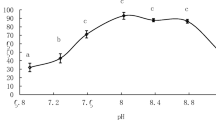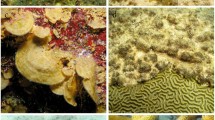Abstract
The effects of pH reduction on the settlement and development of the coral Pocillopora damicornis were investigated. Three different pH treatments (pH = 7.6, 7.9, and 8.1) were used. In addition, water quality (temperature, salinity, total alkalinity) around the study site was monitored. The results showed significant differences in the settlement rates of Pocillopora damicornis larvae between pH treatments (p ≤ 0.05). A decrease in pH levels caused a strong decline in larval settlement rate. In addition, at pH 7.6 and 7.9, all larvae were unable to complete metamorphosis, and metamorphosis delay was observed. Field monitoring showed low fluctuation of all seawater parameters within 24 hours, and there was no difference between seasons. From this study, a strong negative effect of pH reduction on P. damicornis larvae was observed. Although the function of physiology is still not clearly understood, correlations are likely to exist.
Similar content being viewed by others
References
Adey WH (1998) Coral reefs: algal structured and mediated ecosystems in shallow, turbulent, alkaline waters. J Phycol 34:393–406
Albright R, Langdon C (2011) Ocean acidification impacts multiple early life history processes of the Caribbean coral Porites astreoides. Glob Change Biol 17(17):2478–2487
Albright R, Mason B, Miller M, Langdon C (2010) Ocean acidification compromises recruitment success of the threatened Caribbean coral Acropora palmata. P Natl Acad Sci USA 107(107):20400–20404
Armenteros M, Ruiz-Abierno A, Sosa Y, Pérez-Garcia JA (2012) Habitat heterogeneity effects on macro-and meiofauna (especially nematodes) in Punta Francés coral reef (SW Cuban Archipelago). Rev Invest Mar 32(32):50–61
Bignami S, Sponaugle S, Cowen RK (2013) Response to ocean acidification in larvae of a large tropical marine fish, Rachycentron canadum. Glob Change Biol 19(19):996–1006
Chua CM, Schupp P, Leggat W, Baird AH (2012) Effects of ocean acidification on metamorphosis: brooding and spawning larvae. In: Proceedings of the 12th International Coral Reef Symposium, Cairns, 9–13 July 2012, pp 1–5
Comeau S, Edmunds PJ, Spindel NB, Carpenter RC (2013) The responses of eight coral reef calcifiers to increasing partial pressure of CO2 do not exhibit a tipping point. Limnol Oceanogr 58(58):388–398
Crook ED, Cohen AL, Rebolledo-Vieyra M, Hernandez L, Paytan A (2013) Reduced calcification and lack of acclimatization by coral colonies growing in areas of persistent natural acidification. P Natl Acad Sci USA 110(110):11044–11049
Dixson DL, Munday PL, Jones GP (2010) Ocean acidification disrupts the innate ability of fish to detect predator olfactory cues. Ecol Lett 13(13):68–75
Domenici P, Allan B, McCormick MI, Munday PL (2012) Elevated carbon dioxide affects behavioural lateralization in a coral reef fish. Biol Lett 8(8):78–81
Edmunds PJ, Brown D, Moriarty V (2012) Interactive effects of ocean acidification and temperature on two scleractinian corals from Moorea, French Polynesia. Glob Change Biol 18(18):2173–2183
Edmunds PJ, Carpenter RC, Comeau S (2013) Understanding the threats of ocean acidification to coral reefs. Oceanography 26(26):149–152
Erez J, Reynaud S, Silverman J, Schneider K, Allemand D (2011) Coral calcification under ocean acidification and global change. In: Dubinsky Z, Stambler N (eds) Coral reefs: an ecosystem in transition, Springer, New York, pp 151–176
Esbaugh AJ, Heuer R, Grosell M (2012) Impacts of ocean acidification on respiratory gas exchange and acid-base balance in a marine teleost, Opsanus beta. J Comp Physiol B 182(182):921–934
Gabay Y, Fine M, Barkay Z, Benayahu Y (2014) Octocoral tissue provides protection from declining oceanic pH. Plos One 9(9):e91553
Gattuso JP, Buddemeier RW (2000) Ocean biogeochemistry: Calcification and CO2. Nature 407(6802):311–313
Harrington L, Fabricius K, De’ath G, Negri A (2004) Recognition and selection of settlement substrata determine post-settlement survival in corals. Ecology 85(85):3428–3437
Harrison PL, Wallace CC (1990) Reproduction, dispersal and recruitment of scleractinian corals, Chapter 7. In: Dubinsky Z (ed) Coral reef, ecosystems of the world Vol. 25. Elsevier Sci Publ, Amsterdam, pp 133–207
Hendriks IE, Duarte CM, Alvarez M (2010) Vulnerability of marine biodiversity to ocean acidification: a meta-analysis. Estuar Coast Shelf Sci 86(86):157–164
Hoegh-Guldberg O, Mumby PJ, Hooten AJ, Steneck RS, Greenfield P, Gomez E, Harvell CD, Sale PF, Edwards AJ, Caldeira K, Knowlton N, Eakin CM, Iglesias-Prieto R, Muthiga N, Bradbury RH, Dubi A, Hatziolos ME (2007) Coral reefs under rapid climate change and ocean acidification. Science 318:1737–1742
Kuanui P, Chavanich S, Raksasab C, Viyakarn V (2008) Lunar periodicity of larval release and larval development of Pocillopora damicornis in Thailand. In: Proceedings of the 11th International Coral Reef Symposium, Ft. Lauderdale, Florida, 7–11 July 2008, pp 382–384
Kuffner IB, Andersson AJ, Jokiel PL, Rodgers KS, Mackenzie FT (2008) Decreased abundance of crustose coralline algae due to ocean acidification. Nat Geosci 1:114–117
Kurihara H (2008) Effects of CO2-driven ocean acidification on the early developmental stages of invertebrates. Mar Ecol Prog Ser 373:275–284
Lee CS, Walford J, Goh BPL (2009) Adding coral rubble to substrata enhances settlement of Pocillopora damicornis larvae. Coral Reefs 28:529–533
Lewis E, Wallace DWR (1998) Program developed for CO2 system calculations. ORNL/CDIAC-105, Carbon Dioxide Information Analysis Center, Oak Ridge National Laboratory, US Department of Energy, Oak Ridge, Tennessee
Markey KL, Baird AH, Humphrey C, Negri AP (2007) Insecticides and a fungicide affect multiple coral life stages. Mar Ecol-Prog Ser 330:127–137
Marubini F, Ferrier-Pages C, Furla P, Allemand D (2008) Coral calcification responds to seawater acidification: a working hypothesis towards a physiological mechanism. Coral Reefs 27:491–499
McCulloch M, Falter J, Trotter J, Montagna P (2012) Coral resilience to ocean acidification and global warming through pH upregulation. Nat Clim Change 2(2):623–627
Munday PL, Dixson DL, Donelson JM, Jones GP, Pratchett MS, Devitsina GV, Døving KB (2009) Ocean acidification impairs olfactory discrimination and homing ability of a marine fish. P Natl Acad Sci USA 106(106):1848–1852
Mundy CN, Babcock RC (1998) Role of light intensity and spectral quality in coral settlement: implications for depth-dependent settlement? J Exp Mar Biol Ecol 223:235–255
Nakamura M, Ohki S, Suzuki A, Sakai K (2011) Coral larvae under ocean acidification: survival, metabolism and metamorphosis. Plos One 6(6):e14521
Randall CJ, Szmant AM (2009) Elevated temperature reduces survivorship and settlement of the larvae of the Caribbean scleractinian coral, Favia fragum (Esper). Coral Reefs 28:537–545
Sabine CL, Feely RA, Gruber N, Key RM, Lee K, Bullister JL, Wanninkhof R, Wong CS, Wallace DWR, Tilbrook B, Millero FJ, Peng TH, Kozyr A, Ono T, Rios AF (2004) The oceanic sink for anthropogenic CO2. Science 305:367–371
Simpson SD, Munday PL, Wittenrich ML, Manassa R, Dixson DL, Gagliano M, Yan HY (2011) Ocean acidification erodes crucial auditory behaviour in a marine fish. Biol Lett 7(7):917–920
Venn AA, Tambutté E, Holcomb M, Laurent J, Allemand D, Tambutté S (2013) Impact of seawater acidification on pH at the tissueskeleton interface and calcification in reef corals. P Natl Acad Sci USA 110(110):1634–1639
Author information
Authors and Affiliations
Corresponding author
Rights and permissions
About this article
Cite this article
Viyakarn, V., Lalitpattarakit, W., Chinfak, N. et al. Effect of lower pH on settlement and development of coral, Pocillopora damicornis (Linnaeus, 1758). Ocean Sci. J. 50, 475–480 (2015). https://doi.org/10.1007/s12601-015-0043-z
Received:
Revised:
Accepted:
Published:
Issue Date:
DOI: https://doi.org/10.1007/s12601-015-0043-z




